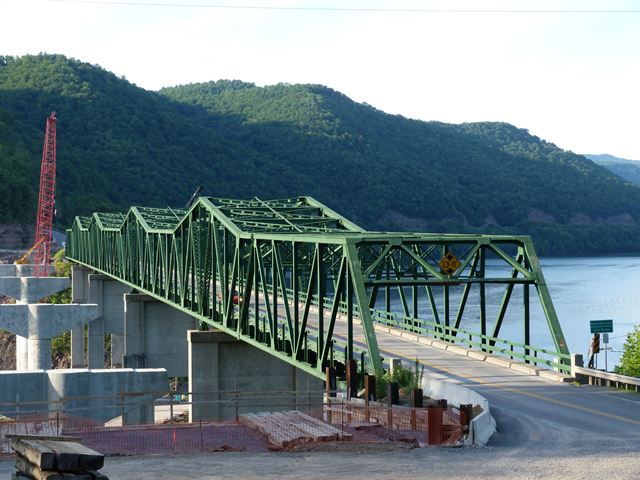We Recommend:
Bach Steel - Experts at historic truss bridge restoration.
BridgeHunter.com Phase 1 is released to the public! - Visit Now
Lilly Bridge
Bluestone Lake Bridge

Primary Photographer(s): Nathan Holth
Bridge Documented: June 5, 2014
Rural: Summers County, West Virginia: United States
1950 By Builder/Contractor: Virginia Bridge and Iron Company of Roanoke, Virginia
Not Available or Not Applicable
278.0 Feet (84.7 Meters)
1,163.8 Feet (354.7 Meters)
24 Feet (7.32 Meters)
5 Main Span(s)
45A039

View Information About HSR Ratings
Bridge Documentation
This bridge no longer exists!
View Archived National Bridge Inventory Report - Has Additional Details and Evaluation
View Historical Articles About This Bridge
View State Level Recordation For This Bridge
View A WVDOT Document Discussing Replacement Project
This bridge is a rare West Virginia example of a cantilever truss bridge. It is not an early example with a 1950 construction date, but its configuration with multiple cantilever units including half-suspended spans is rare. The anchor arms and cantilever arms have a Warren truss configuration, while the suspended spans have a Pratt truss configuration.
The bridge spans are configured as follows: first span, consisting of cantilever arm holding a half-suspended span, with other end of half-suspended span resting on abutment; second span, consisting of two anchor arms; third span, consisting of cantilever arms holding a suspended span, fourth span, consisting of two anchor arms; fifth span consisting of cantilever arm holding a half-suspended span, with other end of half-suspended span resting on abutment.
The bridge was built to accommodate a reservoir created by construction of a dam. Even with the reservoir in place, this bridge still soars far above the normal water level. During construction of the bridge, a disaster occurred and part of the bridge collapsed. A historical photo to the right shows this.
The name, Lilly Bridge, refers to a long-lost community in this area that was submerged when the dam was built.
At the time this bridge was replaced, the State Historic Preservation Office (SHPO) provided the following comments:
The Lilly Bridge was concurred in by the SHPO on March 5, 2010 to be eligible for the National Register of Historic Places under Criterion A and Criterion C for its association with the Virginia Bridge Company and its cantilevered truss design. It is eligible under Criterion A for its association with the creation of the Bluestone Dam as part of the Flood Control Acts of 1936 and 1938. The bridge was built in to span the newly created Bluestone Lake and was named in honor of the flooded town of Lilly. There are only 7 remaining cantilever truss bridges in West Virginia.
During the project planning process, the SHPO questioned why this historic bridge, which was not in the way of its replacement which was built on new alignment next to the historic bridge, could not be left standing for pedestrian use and for its historic value. Given that this bridge was in good physical condition it is very disappointing to see that the DOT refused to allow this. In short, the demolition of this bridge is both not needed, and is a waste of money and history.

![]()
Photo Galleries and Videos: Lilly Bridge
Bridge Photo-Documentation
Original / Full Size PhotosA collection of overview and detail photos. This gallery offers photos in the highest available resolution and file size in a touch-friendly popup viewer.
Alternatively, Browse Without Using Viewer
![]()
Bridge Photo-Documentation
Mobile Optimized PhotosA collection of overview and detail photos. This gallery features data-friendly, fast-loading photos in a touch-friendly popup viewer.
Alternatively, Browse Without Using Viewer
![]()
Maps and Links: Lilly Bridge
This historic bridge has been demolished. This map is shown for reference purposes only.
Coordinates (Latitude, Longitude):
Search For Additional Bridge Listings:
Bridgehunter.com: View listed bridges within 0.5 miles (0.8 kilometers) of this bridge.
Bridgehunter.com: View listed bridges within 10 miles (16 kilometers) of this bridge.
Additional Maps:
Google Streetview (If Available)
GeoHack (Additional Links and Coordinates)
Apple Maps (Via DuckDuckGo Search)
Apple Maps (Apple devices only)
Android: Open Location In Your Map or GPS App
Flickr Gallery (Find Nearby Photos)
Wikimedia Commons (Find Nearby Photos)
Directions Via Sygic For Android
Directions Via Sygic For iOS and Android Dolphin Browser
USGS National Map (United States Only)
Historical USGS Topo Maps (United States Only)
Historic Aerials (United States Only)
CalTopo Maps (United States Only)

